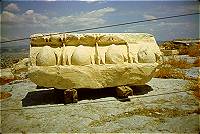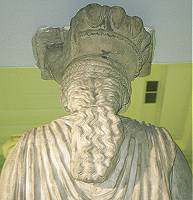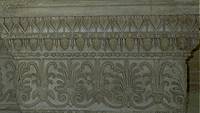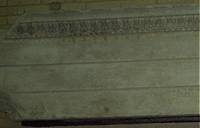ATHENS
Acropolis
Athena Nike
Erechtheum
Parthenon
Propylaia
Acropolis
Museum
South
Slope overview
South Slope lecture
Pnyx
Areopagus
Philopappos
Hill
Agora
Temple
of Olympian Zeus
and Arch of Hadrian
Keramikos
Roman Agora
ATTICA
Brauron
Thorikos
Sounion
Oropos
Marathon
Eleusis
Aigosthena/
Eleutherai
Daphni
Piraeus
MESSENIA
Pylos
Voidokilia
Methoni
Messene
CORINTHIA
Perachora
Corinth
Acrocorinth
Diolkos/Canal
Nemea
Isthmia
BOEOTIA
Thebes
Chaironeia
Orchomenos
Gla
Osios
Loukas
ARGOLID
Epidavros
Nauplion
Mycenae
Argos
Tiryns
ARCADIA
Megalopolis
Overview
Tegea
LACONIA
Mistras
Sparta
Monemvasia
ACHAEA
Kalavrita
NORTHERN
GREECE
scenery
Mount
Olympos
DELPHI
Thermopylae
Naupaktos
Mieza
Edessa
Vergina
Pella
Thessaloniki
ELEIA
Olympia
Chlemoutsi
SARONIC GULF ISLANDS
Aegina
Poros
Hydra
Spetses
CYCLADIC ISLANDS
Santorini
Delos
CRETE
Cnossos
Phaistos
Zakros
|
 |
Dr.
J's Illustrated Erechtheum Lecture
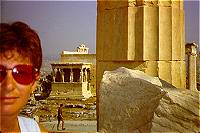 View
from inside the Parthenon. The Erechtheum was built over a long
period of time, since construction was halted during the Peace
of Nikias (starting in 421 BC, this was a brief period of
respite during the Peloponnesian War) and resumed in 410 BC. The
temple was probably completed by 395. View
from inside the Parthenon. The Erechtheum was built over a long
period of time, since construction was halted during the Peace
of Nikias (starting in 421 BC, this was a brief period of
respite during the Peloponnesian War) and resumed in 410 BC. The
temple was probably completed by 395.
|
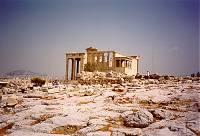
The Erechtheum is a very complicated structure, but it has three
main parts: the main section of the temple, the north porch, and the Porch of the
Caryatids. The main section is again divided into an eastern and a western
cella. In
the foreground is the terrace wall of the old temple.
|
 The
east cella, the large area behind the six Ionic columns, was dedicated to the worship of
Athena Polias. The Panathenaic Procession terminated here, where the olive wood cult
statue of Athena was draped in the peplos offered by the Arrephoroi, elite young Athenian
girls hand-picked for this sacred duty. The
east cella, the large area behind the six Ionic columns, was dedicated to the worship of
Athena Polias. The Panathenaic Procession terminated here, where the olive wood cult
statue of Athena was draped in the peplos offered by the Arrephoroi, elite young Athenian
girls hand-picked for this sacred duty.
|
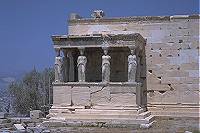 The terrace wall of the Old Temple of Athena is in the foreground. The
building is so difficult to figure out because it spreads over and beyond shrine areas and
must rearrange itself. A good example is how the SW corner of the Caryatid Porch lies atop
the Grave of Cecrops, access to which is gained only via a secret passageway. Do the
Caryatids guard his grave? The terrace wall of the Old Temple of Athena is in the foreground. The
building is so difficult to figure out because it spreads over and beyond shrine areas and
must rearrange itself. A good example is how the SW corner of the Caryatid Porch lies atop
the Grave of Cecrops, access to which is gained only via a secret passageway. Do the
Caryatids guard his grave?
|
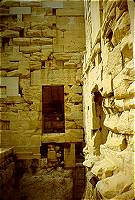
Particularly complicated is the west
cella, accessible by way
of both porches and home to shrines to many deities: altars to Poseidon, Butes and
Hephaestus, and a snake pit dedicated to the chthonic gods. A 32 foot beam ran across its
length; there are cuttings in the wall for a supporting strut, and rosettes decorated
these walls. The ledge above the door to the Caryatid porch held Kallimachos' famous gold
palm-tree lamp. |

View of the Erechtheum from the SW. Pausanias (1.27.2) perpetuates a
mystical truth about Athena's tree: the day after the Persians burned
the Acropolis in 480 BC, he claims, the tree produced a new shoot four
feet long. |
 Tradition has it that this olive tree can
trace its roots back to the tree Athena originally planted in her winning bid for Attica.
Although the tree was cut down by numerous invaders (e.g., Sulla in 86 BC, the Turks in
1456), each time a sprig from the original was saved and replanted. The last replanting
was made in 1952 by members of the American School, who saved the tree from oblivion after
Germans occupying the Acropolis cut it down in 1942. Tradition has it that this olive tree can
trace its roots back to the tree Athena originally planted in her winning bid for Attica.
Although the tree was cut down by numerous invaders (e.g., Sulla in 86 BC, the Turks in
1456), each time a sprig from the original was saved and replanted. The last replanting
was made in 1952 by members of the American School, who saved the tree from oblivion after
Germans occupying the Acropolis cut it down in 1942.
|
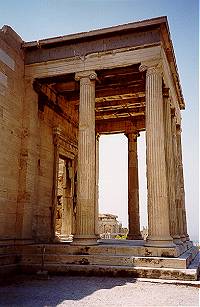
Near the north porch of the Erechtheum is the grave of
Erechtheus, mythical
king of Athens. He is identified with Erichthonius, who is said to be the son of Gaia and
Hephaestus (and reared by Athena), and is later associated with Poseidon. Thus the temple
was from the beginning sacred to both Athena and Poseidon, as well as to
Hephaestus,
father of Erichthonius, and Butes, brother of Erechtheus. Outside this entrance also was
the altar of Zeus Thyechoos, "Zeus Supreme," to whom nothing that breathed was
offered - not even wine!
|
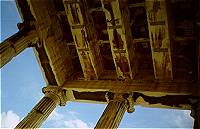
The columns of the North Porch sport a guillache pattern and
held glass inserts of four colors. A hole in the floor allows one to see the marks of
Poseidon's trident, and an open space in the ceiling allows Poseidon to re-hurl his
trident, should he wish.
|
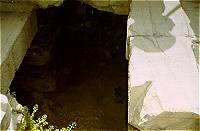 Although certainly remarkable, this three-pronged mark in the
rock is not the site of the salt water well that Poseidon caused to be by striking the
ground with his trident. That long-lost well would have been just inside the north door to
the cella. Pausanias said that on a windy day, the sound of waves could even be heard
coming from it. (1.26.6) Although certainly remarkable, this three-pronged mark in the
rock is not the site of the salt water well that Poseidon caused to be by striking the
ground with his trident. That long-lost well would have been just inside the north door to
the cella. Pausanias said that on a windy day, the sound of waves could even be heard
coming from it. (1.26.6)
|
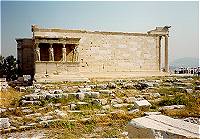 This is the south porch of the
Erechtheum, commonly called the Caryatid
Porch. Who these Caryatids are meant to represent is as hotly debated today as it was in
antiquity. Are they criminals forced to bear a heavy burden? The Arrephoroi chosen to
deliver the peplos to Athena? Young initiates of Artemis at Brauron? A group of
upper-class Athenian women? Or in this case is a pretty support beam just a pretty support
beam? This is the south porch of the
Erechtheum, commonly called the Caryatid
Porch. Who these Caryatids are meant to represent is as hotly debated today as it was in
antiquity. Are they criminals forced to bear a heavy burden? The Arrephoroi chosen to
deliver the peplos to Athena? Young initiates of Artemis at Brauron? A group of
upper-class Athenian women? Or in this case is a pretty support beam just a pretty support
beam?
|

This close-up of the Caryatid Porch shows how the women seem
to be caught in mid-stride: the three on the left have bent left knees (note how even in
marble the garment drapes naturally), while the remaining three bend the right knee.
|
|

The Caryatid Lord Elgin brought out of
Greece and sold to the British Museum in 1816. It is the best preserved of the 6
Caryatids, the other five of which were moved in 1979 into a nitrogen-filled chamber in
the Acropolis Museum in Athens, but too late to save them from the ravages of pollution.
More photos to be uploaded soon...
|
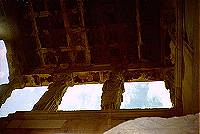 The ceiling coffers of the Caryatid Porch of the Erechtheum
are almost entirely intact. Some sources say that the portico ceilings were paneled and
painted dark blue with gold stars (much like the east portico of the
Propylaia), and some
say that they were inset with panels of variously colored glass. The ceiling coffers of the Caryatid Porch of the Erechtheum
are almost entirely intact. Some sources say that the portico ceilings were paneled and
painted dark blue with gold stars (much like the east portico of the
Propylaia), and some
say that they were inset with panels of variously colored glass.
|
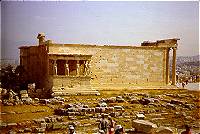
View of Erechtheum with the foundation of an earlier, 6th
century, Temple of Athena in the foreground. This is the only whole foundation of a
pre-Persian invasion building on the Acropolis.
|
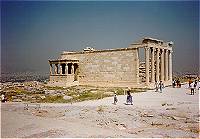
Here two of the Erechtheum's three pedimental areas are visible (the third
is over the north porch), but none ever had pedimental sculpture. Although many pieces of
the frieze survive, its theme is not known.
|
|
Huge
fragment of egg and dart molding of the Erechtheum (above left). The
Caryatids, too, are crowned with egg and dart molding (above right is a
close-up of the Caryatid in the British Museum) The building was known
for its particularly elaborate architectural decoration, and much of it
can be seen in the British Museum (you have to go to the basement).
Below on the left is an anta capital from east porch of Erechtheum, and
on the right is architrave block from the same porch:
|
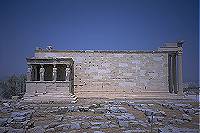 Reconstruction generally follows the principle that one should be able to
tell the original from the new - that is why the replacement blocks are a lighter color.
The purpose of reconstruction is to use only as much new material as is necessary to
provide a true representation of the old and allow appreciation of it in its fullness -
not to trick the viewer into thinking that something new really dates to antiquity. Reconstruction generally follows the principle that one should be able to
tell the original from the new - that is why the replacement blocks are a lighter color.
The purpose of reconstruction is to use only as much new material as is necessary to
provide a true representation of the old and allow appreciation of it in its fullness -
not to trick the viewer into thinking that something new really dates to antiquity.
|
With
special thanks to Professor John Younger of Duke University for his help in making these
pages more accurate. Any errors are my own.
|

















